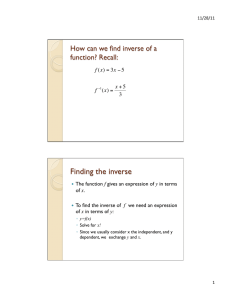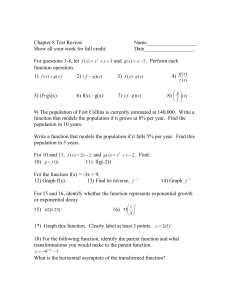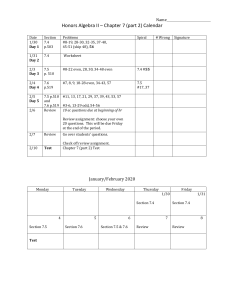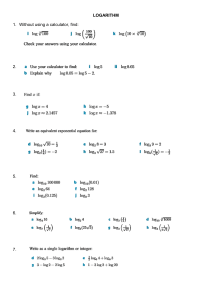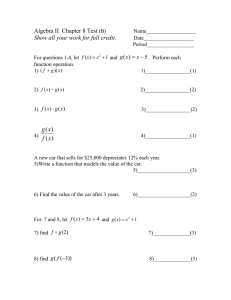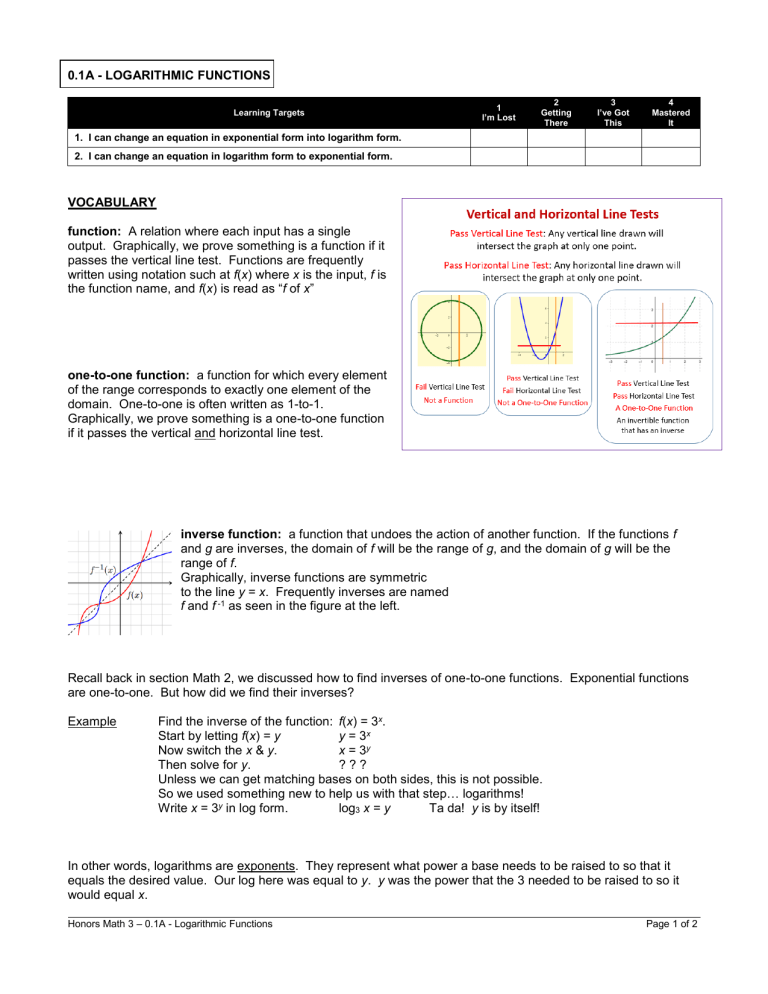
0.1A - LOGARITHMIC FUNCTIONS
Learning Targets
1
I’m Lost
2
Getting
There
3
I’ve Got
This
4
Mastered
It
1. I can change an equation in exponential form into logarithm form.
2. I can change an equation in logarithm form to exponential form.
VOCABULARY
function: A relation where each input has a single
output. Graphically, we prove something is a function if it
passes the vertical line test. Functions are frequently
written using notation such at f(x) where x is the input, f is
the function name, and f(x) is read as “f of x”
one-to-one function: a function for which every element
of the range corresponds to exactly one element of the
domain. One-to-one is often written as 1-to-1.
Graphically, we prove something is a one-to-one function
if it passes the vertical and horizontal line test.
inverse function: a function that undoes the action of another function. If the functions f
and g are inverses, the domain of f will be the range of g, and the domain of g will be the
range of f.
Graphically, inverse functions are symmetric
to the line y = x. Frequently inverses are named
f and f -1 as seen in the figure at the left.
Recall back in section Math 2, we discussed how to find inverses of one-to-one functions. Exponential functions
are one-to-one. But how did we find their inverses?
Example
Find the inverse of the function: f(x) = 3x.
Start by letting f(x) = y
y = 3x
Now switch the x & y.
x = 3y
Then solve for y.
???
Unless we can get matching bases on both sides, this is not possible.
So we used something new to help us with that step… logarithms!
Write x = 3y in log form.
log3 x = y
Ta da! y is by itself!
In other words, logarithms are exponents. They represent what power a base needs to be raised to so that it
equals the desired value. Our log here was equal to y. y was the power that the 3 needed to be raised to so it
would equal x.
Honors Math 3 – 0.1A - Logarithmic Functions
Page 1 of 2
VOCABULARY
logarithmic function to the base a:
Denoted by y = loga x (read as “y is the logarithm to the base a of x”), where a > 0 and a ≠ 1, and is defined by
y = loga x if and only if x = ay
The domain of the logarithmic function y = loga x is (0, ) . In other words the base of a log must be positive.
natural logarithm (ln):
a logarithm with a base of e, denoted by ln
Learning Target 1: Examples
Change each exponential expression to an equivalent expression involving a logarithm.
1.
512 = 83
2.
2.52 = 6.25
3.
3x = 16
4.
x3 = 29
5.
ex = 13
6.
m = ba
Learning Target 2: Examples
Change each logarithmic expression to an equivalent expression involving an exponent.
7.
log3 9 = 2
8.
1
log 2 = −4
16
9.
log4 9 = x
10.
ln 10 = x
Honors Math 3 – 0.1A - Logarithmic Functions
Page 2 of 2

